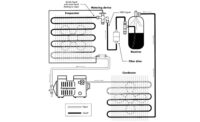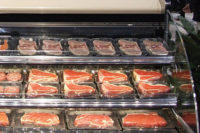 Today, we are going to look at issues related to a partially restricted filter/drier. For this purpose I have included a service checklist (Table 1) as well as a number of illustrations.
Today, we are going to look at issues related to a partially restricted filter/drier. For this purpose I have included a service checklist (Table 1) as well as a number of illustrations.
The filter drier (Figure 1) is located in the refrigeration system’s liquid line. The liquid line is located between the receiver and metering device (Figure 2). Filter driers can become restricted from moisture, sludge, dirt, or oil. However, any restriction or damage to the liquid line from the receiver outlet to the metering device inlet will have similar symptoms as a restricted filter drier. Because the filter drier is located in the liquid line, a restricted filter drier can now be referred to as a liquid-line restriction. Assume, for sake of discussion, that the refrigeration system is a TXV/receiver system employing a filter drier and sight-glass. The system has R-134a as the working refrigerant.
Causes
Causes for restricted liquid lines or restricted components in the liquid line can be:
• Restricted filter drier from moisture, dirt, oil, or sludge;
• Restricted TXV screen or orifice;
• Kinked liquid line;
• Restricted liquid-line solder joint; and
• Receiver outlet valve (king valve) partially closed off.
Many technicians believe that when any part of the system’s high side is restricted or plugged, head pressures will elevate. This is simply not the case, especially on a TXV/receiver system. A restricted liquid line will starve the evaporator of refrigerant, causing low evaporator pressures. With a starved evaporator, the compressor will also be starved of refrigerant and there will be little heat for the condenser to reject. This small amount of heat to reject will cause a low condensing pressure and temperature. Most of the refrigerant will now be stored in the receiver simulating a pumped-down refrigeration system.
Symptoms
Symptoms for a restriction can be:
• Higher than normal discharge temperature;
• High superheats;
• Low evaporator pressures;
• Low condensing pressures;
• Normal to a bit high condenser subcooling;
• Low condenser splits;
• May be a local cool spot or frost after the restriction;
• Low amp draw; and
• Short cycle the low pressure control (LPC).
Higher than Normal Discharge Temperature — High discharge temperatures are caused from high compressor superheats and high compression ratios. A starved evaporator from the liquid line (filter drier) restriction will cause the high superheats. High compression ratios from the low evaporator pressure will cause high heat of compressions, thus high discharge temperatures also. This is assuming there is still some mass flow rate of refrigerant through the system. The severity of the restriction in the filter drier will determine how high the discharge temperature will be. If the system becomes completely restricted, the compressor will pump down the system and stay off, or short-cycle sometimes on the low-pressure control.
High Superheats — Both evaporator and compressor superheats will be high. This is caused from the TXV, evaporator, and compressor being starved of refrigerant from the liquid-line restriction. Most of the refrigerant will be in the receiver, with some in the condenser.
Low Evaporator Pressure — The low evaporator pressure is caused from the TXV and compressor being starved of refrigerant. The compressor is trying to draw refrigerant from the evaporator through the suction line, but the liquid-line restriction is preventing refrigerant from entering the evaporator. This will cause the compressor to put the evaporator in a low-pressure situation.
Low Condensing Pressure — Since both the evaporator and compressor are being starved of refrigerant, so will the condenser. Reduced refrigerant to the evaporator will cause a reduced heat load to be delivered to the condenser. The condenser in turn does not have to elevate its temperature and pressure to reject heat. Most of the refrigerant will be in the receiver.
Normal to a Bit High Condenser Subcooling — Since the condenser has a low-heat rejection load, it is not condensing much vapor to liquid. All of the liquid in the condenser will probably sit there for a while and subcool because of the low refrigerant flow caused from the restriction in the filter drier. The receiver will have a reduced flow in and out of it also. Most of the refrigerant will be in the receiver, with some in the condenser. If the receiver is in a hot ambient, subcooling may be lost as refrigerant sits in the receiver. This is why some commercial systems have receiver bypasses for certain situations. Receiver bypasses are nothing more than a liquid-line solenoid valve controlled by a thermostat, which will bypass liquid around the receiver to the liquid line.
Low Condenser Splits — Because the condenser is being somewhat starved, there is not much heat to reject from the evaporator being starved. This will cause low-condenser splits. Remember, the split is the temperature difference between the condensing temperature and the ambient.
Local Cold Spot or Frost Where Restriction Occurs — Liquid refrigerant flashing to vapor might occur at the restricted drier if the restriction is severe enough. Simply running your hand along the liquid line and on the filter drier may find a local cold spot. A thermistor on the liquid line about 12 inches before the entrance of the TXV should not be colder than the ambient that surrounds it. If it is, there is a sure restriction somewhere upstream.
There are a lot of times when a filter drier may be partially plugged and the technician cannot feel a temperature difference across it with their hands. The truth is that humans can only distinguish a temperature difference of more than 10˚F across something. This is only if the temperature differences are a little higher than their body temperature of 98.6˚. A filter drier in an R-134a system with a condensing temperature of 110˚ would need about 20-psi pressure drop to exhibit a 10˚ temperature difference. Because of this, many filter drier restrictions go unchecked by technicians because they are difficult to sense by touch and feel. The use of a sight glass after the filter drier to show flashing will assist the technician. This same sight glass will assist in system charging. A moisture-indicating sight glass will alert the technician if the system is contaminated with moisture by changing colors.
With a restriction in the liquid line before the sight glass, bubbles are sure to occur in the sight glass. Many technicians believe that a bubbling sight glass means nothing but an undercharge of refrigerant. This is simply not true. On start-up, with some refrigeration systems, if there is a large load on the system, bubbling and flashing could occur in the sight glass downstream of the receiver. This bubbling is caused from a pressure drop at the entrance of the outlet tube of the receiver. Bubbling could also occur during rapid increases in loads. The TXV could be opened wide during an increase in load and some flashing could occur even though the receiver has sufficient liquid. Also, sudden changes in head-pressure control systems, which may dump hot gas into the receiver to build up head pressure, often will bubble a sight glass, even though there is sufficient liquid in the receiver to form a seal on the receiver’s dip-tube outlet. A sight glass on the receiver would prevent technicians from overcharging in this case, but would cost the manufacturer a bit more money initially.
A sight glass on the liquid line before the TXV would also help let the technician know if any liquid flashing is occurring before the TXV. This flashing could be from loss of subcooling or too much static, and/or friction-pressure drop in the liquid line before it reaches the TXV.
There is a big difference between a bubbling sight glass and a low flow-rate sight glass. If bubbles are entrained in the liquid, this is a sign of a pressure drop causing liquid flashing, or an undercharge of refrigerant causing vapor and liquid to exit the receiver because of no subcooling. Remember, the condenser subcooling will be low if an undercharge is causing the bubbling of the sight glass. Otherwise, the bubbling sight glass could mean a restricted liquid line, restricted filter drier, loss of receiver or liquid-line subcooling from a hot ambient, or static and friction losses in the liquid line are too great.
On the other hand, a low-refrigerant flow-rate sight glass is an indication that the system is about ready to cycle off because the box temperature has pulled down to a low enough temperature. It is at these times that the system is at its lowest heat loads and the refrigerant flow rate through the system will be the lowest. The sight glass may be only quarter-to-half full with no entrained bubbles. This situation is especially true with horizontal liquid lines.
Do not add refrigerant in this situation because you will overcharge the system. The overcharge will be noticed at the higher heat loads. The low heat loads cause the system to be at its lowest suction pressure, thus the density of refrigerant vapors entering the compressor will be lowest. Because of the lowest evaporator pressures, the compression ratio will be high, causing low-volumetric efficiencies, thus low refrigerant flow rates. There is usually plenty of subcooling in the condenser but the sight glass will only be partially filled. So, do not confuse a low refrigerant flow rate sight glass with a bubbly sight glass which has bubbles entrained in the liquid.
A sight glass after the filter drier is a good method to tell if the drier is starting to plug because of the refrigerant flash from the added pressure drop in the restricted drier. Filter driers can be purchased with Shrader valves (pressure taps) on their inlets and outlets (Figure 3). A pressure drop of more than 2 psi measured with the same gauge means that the drier has started to restrict. Also, as mentioned before, a sight glass right before the TXV will surely tell the technician if liquid flashing is occurring there. Just because the sight glass is bubbling doesn’t necessarily mean an undercharge, so do not automatically add refrigerant. A lot of systems are found with the receiver completely filled with liquid because the service technician kept charging refrigerant trying to clear up the sight glass.
Also, many refrigerant blends may often slightly bubble a sight glass because of them containing two, three, four, or even five different refrigerants in the same blend, and all having different properties and characteristics. Always consult with the refrigerant-blend manufacturer for more detailed information on refrigerant-blend behavior.
Low Amp Draw — Because the compressor is being starved of refrigerant from the restriction in the liquid line, it will not have to work as hard in compressing what vapors do pass through it. The low density of the vapors from the low evaporator pressure will require less work from the compressor, requiring a low amp draw.
Short Cycle the Low-Pressure Control — The low-pressure control (LPC) will cycle the compressor off and on from the low evaporator (suction) pressures. Once off, refrigerant will slowly enter the evaporator and cycle the compressor back on. This on and off of the compressor will continue until the problem is fixed.
Remember, systematic troubleshooting with a system checklist is the only sure way to find the actual cause of any system problem.
Publication date: 3/4/2013











